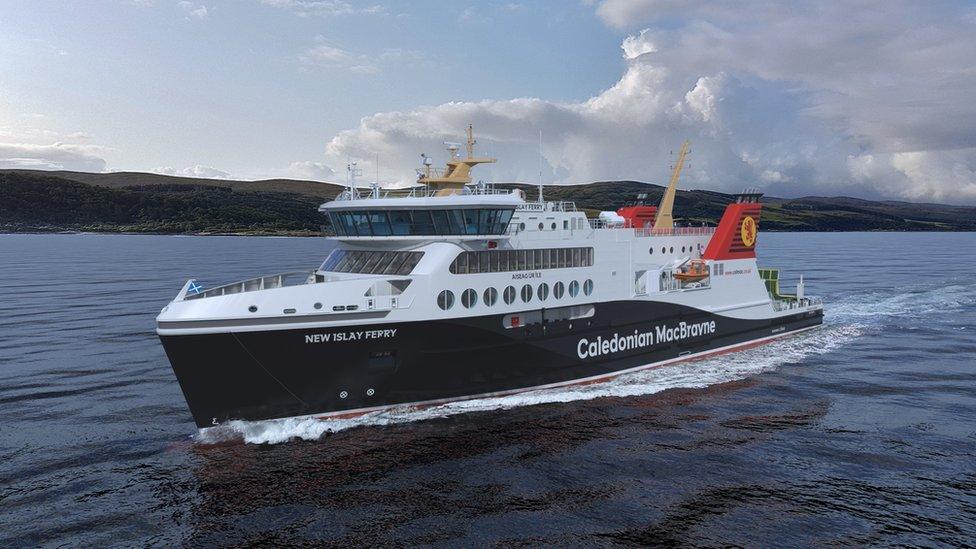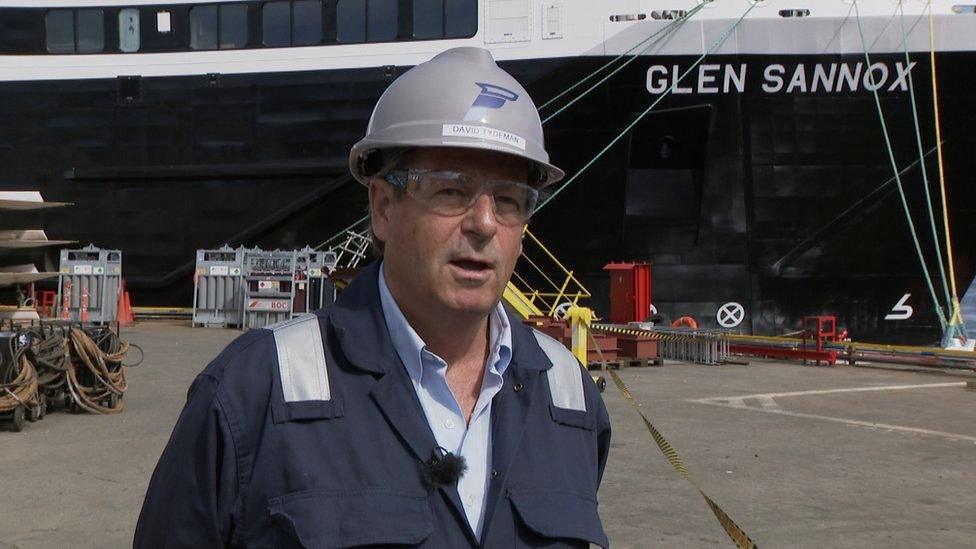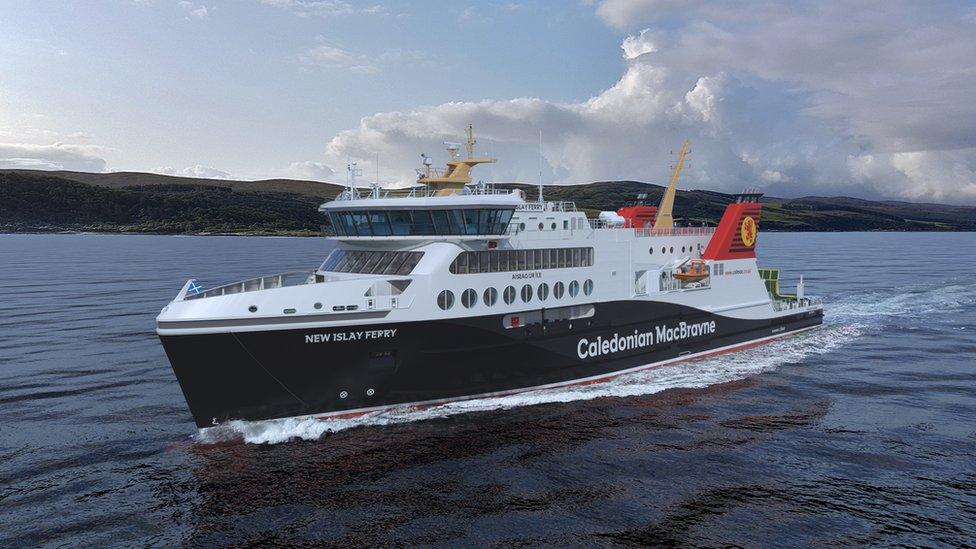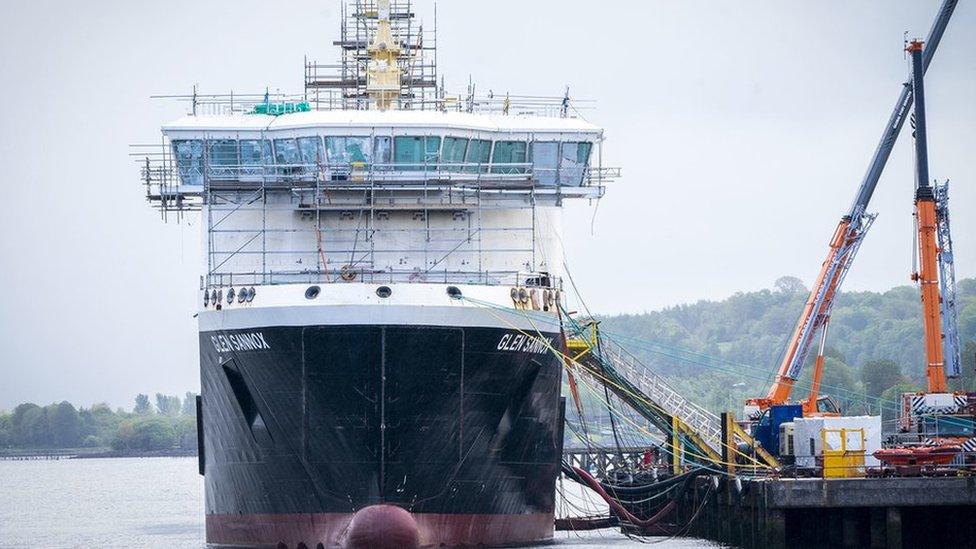New CalMac ferries for Western Isles to be built in Turkey
- Published

The new ships will be based on the specification for two vessels being built for the Islay route
Two new ferries for the CalMac fleet are to be built in Turkey.
The Scottish government announced in October it would spend £115m on new vessels for the Skye, Harris and North Uist service.
Ferries agency CMAL has now named the preferred bidder as Turkish yard Cemre, which is already building two ships for CalMac's Islay route.
The nationalised Ferguson shipyard did not bid for the latest order and was not shortlisted for the Islay ships.
CMAL's head of vessels Jim Anderson said: "This is a big step forward in procuring two new vessels for the Little Minch routes to Lochmaddy and Tarbert.
"These ferries will deliver dedicated services to North Uist and Harris in the peak season, rather than the shared vessel operation currently in place."
Scottish Conservative transport spokesman Graham Simpson said: "It is scandalous that the SNP has put Scottish shipbuilding in the position where it cannot be considered suitable for such a job."
'Stark reminder'
Scottish Liberal Democrat economy spokesman Willie Rennie said: "It looks like the contract for yet another two ferries is off to Turkey which is a stark reminder of the mismanagement of the ferry construction programme under the SNP."
In another development, the chief executive of the Ferguson Marine has been explaining why two CalMac ships still being built at the shipyard have ended up costing so much more than the original £97m contract price.
David Tydeman advised MSPs in September that the yard would require an extra £72m to complete them, taking the total cost to £277m, not including £45m of government loans to the yard's former owners.

Ferguson chief executive David Tydeman took over running the shipyard in the spring of 2022
In a letter to MSPs on the public audit committee, external he said the key reasons were:
£50m of overheads incurred because the build has taken so much longer than anticipated
Inflation and better knowledge of the complexity of the ships adding £40m
About £90m of costs due to management and build errors coupled with the Covid pandemic and recovery from administration
The contract for the two ships, Glen Sannox and hull 802, was awarded to the Ferguson shipyard in 2015, a year after businessman Jim McColl rescued it from administration.
But the build ran into serious trouble and a bitter dispute developed between ferries agency CMAL and Mr McColl's company FMEL.
In 2019 the shipyard went back into administration, and was nationalised. Glen Sannox is now due for delivery next May while 802 will not be finished until 2024.
In his letter, Mr Tydeman said a decision by FMEL to start construction before the design was complete was a significant factor in what went wrong.
Jim McColl has said the blame for that rests with CMAL which, he says, put the contract out to tender without a properly developed concept design, and later repeatedly asked for design changes.
CMAL denies that, and claims that by the terms of the contract, responsibility for the design of the ships rests with the shipyard.
Mr Tydeman is hoping that Ferguson Marine will in future be awarded the contract to replace seven smaller CalMac ships, a type of vessel the yard has a track record of delivering on time and on budget.
He is also looking to take on work from BAE Systems on the MoD's Type 26 frigates which are under construction in Glasgow.


It has taken a while, but at last, it has dawned on those who commission the ferries serving the Hebrides and Clyde might that it might work better as a fleet if it had a small range of ships.
That should make them easier to move between CalMac routes, with standardised facilities at ports, more straight-forward maintenance and inter-changeable crew. It ought to make them more efficient and cheaper to design and to build.
Airlines fly a limited range of aircraft (of different sizes) for similar reasons, but CalMac has been slow to learn the lessons.
That procurement strategy would replace a hotch-potch of different designs, meaning maintenance of the ageing fleet is particularly difficult, as is deployment of replacement ferries when one is out of service.
Perhaps by no coincidence, a standardised fleet built on an assembly line, with regular launches, tied in with a lifetime service contract, was one of the ideas that industrialist Jim McColl was pushing when he owned the Ferguson shipyard in Port Glasgow.
The Scottish government's procurement agency, Caledonian Maritime Assets Limited, thought it knew better. Jim McColl's ownership was put into administration, and CMAL pushed on with the old strategy, under government ownership of the yard.
Until now. Four ferries are now being built to the same spec, two for the Islay-Kennacraig route and two for the Uig-Lochmaddy-Tarbert triangle across the Minch.
That moves closer to the preference of many islanders for more, smaller ferries, providing a more convenient timetable and an assurance that at least one ought to be working.
The catch is that this is being delivered by shipyard workers in Turkey. Other countries have replaced bespoke shipbuilding, just as they have for offshore energy fabrication.
Again, Scottish heavy engineering is being made to look rusty. And turning again to Turkey to build its ships doesn't say much for the Scottish government's industrial strategy.
- Published26 October 2022

- Published27 September 2022
